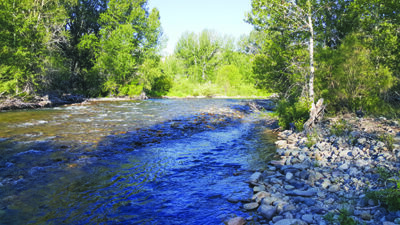By Hannes Thum
 The annual cycle of a river like the Big Wood is pretty straightforward. Snowpack-driven runoff in the springtime causes the river to rise and swell and speed up as water from the mountains enters the river (sometimes rapidly) on its way downstream. During this time, water can cover a lot of land that is otherwise dry the rest of the year. As spring changes into summer and most of the snowpack has melted, the river tends to settle into summertime flows, the channel becomes more defined, and the water is more confined by its banks and bars. Into the fall and winter, flows are at their lowest and will continue to head toward a (relative) trickle until the next year’s springtime runoff. And so it repeats.
The annual cycle of a river like the Big Wood is pretty straightforward. Snowpack-driven runoff in the springtime causes the river to rise and swell and speed up as water from the mountains enters the river (sometimes rapidly) on its way downstream. During this time, water can cover a lot of land that is otherwise dry the rest of the year. As spring changes into summer and most of the snowpack has melted, the river tends to settle into summertime flows, the channel becomes more defined, and the water is more confined by its banks and bars. Into the fall and winter, flows are at their lowest and will continue to head toward a (relative) trickle until the next year’s springtime runoff. And so it repeats.
But those springtime floods have a real impact on the shape of the river bed. It’s important to note that rocks and gravel and sand all move when the river is high—during really high flows you can actually hear rocks moving underwater if you listen carefully. A term that you often hear to describe a river like ours, especially amongst flyfisher-people, is a “freestone river,” and that’s because of the way spring runoff can rearrange the stonework of the river each year.
What does a river reveal after the spring flows recede?
One fascinating thing that it reveals is something called “imbrication,” which occurs during spring floods but isn’t visible until the floods are over. Imbrication describes the way that rocks and cobbles get laid down in a certain way during those high springtime flows, which then are revealed when the river shrinks away.
What does it look like? Well, it looks a little bit like bricks (and that’s how I remember the word—as in “im-brick-ation”). Picture your classic river rock: rounded and maybe somewhat flattened from all of those years rolling along underwater. Now, picture a whole bunch of them all sitting together in a way that almost looks like somebody took the time to lay them out carefully, like pavers in a driveway or like bricks in a wall. They’ll be tilted a bit, with their higher ends pointed downstream to the direction of the flow, because they have found the perfect angle to rest at which the rushing water can no longer flip them up or down (and if they did get flipped, they’d roll on down the river to another spot).
That “somebody” that laid the rocks that way is, of course, the water itself. And so even if you go look at the river today (and the river is quite low today, because we’ve been having some record-breaking low flows this year), imbrication becomes a reminder that the river changes dramatically from day to day and year to year. All of those rock bars and sandy beaches and cobble runs that you see out of the water today were deposited there by past high water events. And imbricated rock bars, to me, are the most dramatic thumbprint of those flows—the most unique and unmistakable artform that only spring floods could have left behind.


